Sensovation Corporation Sees Future of Health Care
Sensovation Corporation Sees Future of Health Care

Sensovation Corporation, located at 4234 Hacienda Drive, is an OEM supplier of optical systems that companies use to add or improve the imaging detection capability of their instruments. Sensovation's specialized cameras and detectors are used primarily in instrumentation for the medical and biotechnology fields in applications such as genetic analysis, DNA sequencers, and what is referred to as lab-on-chip devices which combine multiple laboratory functions on a computer chip used in conjunction with micropumps and flowsensors to analyze blood and other fluids.
Electronic image detection produces a huge amount of data, enough to significantly slow a system in which image data are acquired and analyzed with the same processor that controls other system functions. An important part of Sensovation's technology is what it calls "intelligent sensing" - the sensors do more than just detect. The company compares its sensors to the workings of the human eye, which processes a large portion of the information it receives on the retina and automatically handles activities such as pupil response and focusing. Sensovation's intelligent sensors analyze data and control instrument processes in real time, capabilities that improve the performance of test equipment. Increased speed is significant for one of the major applications of Sensovation's technology - the discovery of medically effective drugs.
"The model for drug discovery has gone from Madam Curie to Henry Ford," says Barry Weinstein, Sensovation's general manager. "You don't have someone mixing test tubes by hand any more. You take a very small sample and put it on a tray with, for example, 384 tiny holes on it, and through automation you add different chemicals at each point, very small quantities. Then our sensors detect and analyze the color variations that occur."
Scientists study the changes caused by the chemical combinations and decide which to study further and, just as important, which to rule out as unpromising. The ability to process thousands of samples quickly makes it possible to develop viable medicines in less time. "With the human genome project being completed," explains Weinstein, "there is a huge rush to map out the genomes and the proteins, genes, etc., and find out what works and what doesn't in terms of potential medicines."
Beyond streamlined drug discovery is what is called "point of care" - performing analysis and diagnosis in real time. In collaboration with the Steinbeis Transfer Center for Medical Biophysics in Heidelberg, Germany, Sensovation has developed the core component of a diagnostic instrument for diagnosing AIDS and monitoring the efficiency of AIDS medication. The toaster-sized instrument is being built by a Sensovation customer and will be suitable for mobile use in the field by non-scientific staff. Current systems of this kind are the size of a refrigerator and require a trained staff in a well-equipped lab.
"What you are seeing in the biotech industry is basically a repeat of what happened in electronics 30 years ago," says Weinstein. "Things are getting smaller, cheaper, and more specialized. The main thrusts of all this are drug discovery and point of care - going to a doctor and having them take 30 seconds to do genetic testing on you so they can make custom medicine for you right there on the spot. Our products are making that possible."
Sensovation Corporation is an independent subsidiary of Sensovation AG in Germany and a strategic partner of Roche Diagnostics, also located in Hacienda.
Photo: (Left to right) Jon Mortola, Gregor Jehle, and Barry Weinstein of Sensovation are pioneering the use of optical detectors in medicine and biotech.
Also in this issue...
- OnWafer Technologies Gets Inside the Process Zone
- Huntington Learning Center Celebrates 20th Anniversary
- Business Bits
- Executive Profile: A Booming Business is the Result of Christina Petrosky's Focus on Family
- Sensovation Corporation Sees Future of Health Care
- Diablo Funding Group Serves Both Wholesale and Retail Mortgage Markets
- Hacienda's Web Site Offers Information at Your Fingertips
- Over 600 from Throughout the Area Expected at the Convention and Visitors Bureau's 10th Annual Tri-Valley Regional Mixer
- For Members of the Tri-Valley Sustainable Business Alliance, It's Easy Being Green
- Tri-Valley Animal Rescue Offers "Claws for Paws" At Second Annual Crab Feed
- Hacienda Index
- Calendar




